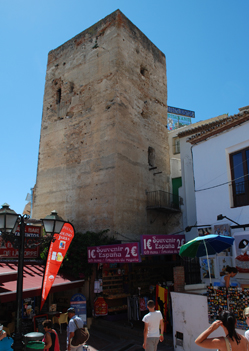 |
| Casa de los Navajas dates back to 1925. |
Torremolinos History
Pre-history, Moors, Catholic Re-conquest, and 20th Century
by Chris Chaplow
PREHISTORY
Prehistoric human skulls have been found in the limestone caves that litter the mountain behind the town. One of them known as the Tapada cave yielded evidence of Bronze Age inhabitation in the shape of a Bell Beaker burial of around 1500 BC. Remains were also found in the caves that used to exist in the Punta de Torremolinos.
The Phoenicians made a settlement at Cerro de Villar, the island city in the Guadalhorce estuary.
The Romans built a number of factories and villas alongside their coast road linking Málaga and Cádiz. At this time the Guadalhorce estuary was seven kilometres wide and the hills of Torremolinos were the first solid ground. The road took a route from Churriana through Los Alamos and along the seafront at Playamar.
In the 1990s a small Roman necropolis with 23 tombs was discovered in the San Luis building in Plaza de Cantabria. The population at this time was 2,000
MOORS

The 14th Century Torre de Pimentel.
The Moors of the Nazari dynasty that ruled Málaga from the 13th to the 15th century built a 12-metre defensive tower which is the one that stands today at the end of Calle San Miguel. The Catholic monarchs re-conquered Málaga in 1487. The tower was referred to in 1497 ordinances as "Torre de los Molinos".
CATHOLIC RE-CONQUEST
In 1502, it came under the rule of Málaga with the name of "Torres de Pimentel" (the towers of Pimentel), in honour of Rodrigo Pimentel, Count of Benavente, to whom most of the lands were given in thanks for his cooperation in providing horses and food during the siege of Málaga.
There were recorded attacks by Barbary pirates in 1522 and 1524 when a number of young men were captured and taken to Africa for the slave trade. Over the next 200 years the population dwindled, perhaps through migration to the safer positions of Málaga city.
During the War of Spanish Succession, in 1702, an English-Dutch fleet commanded by Admiral Sir George Rooke attacked the French fleet leaving Málaga port. The houses and mills of Torremolinos were destroyed.
The defences were improved with the construction in 1763 of Castillo de Santa Clara and, on a hill in Montemar, La Batería. The population began to grow from a 1769 census of 106 to 850 as reported in an 1849 document. Fourteen water mills were driven by the little streams that then flowed down to El Bajondillo beach.
Lady Louisa Tenison, who was travelling in Torremolinos in 1850, noted that "most of the bread consumed in Málaga was made". She also noted, "A man by the name of Parady has a very pretty villa here and at which strangers can make arrangements to stay, and it is certainly a desirable place at which to spend a little time during the spring and summer months."
20th CENTURY
Diverting the streams to keep Málaga in water did not help Torremolinos and by the early 1920s it had declined again to the point that the town was in debt to the tune of 252,288 pesetas (€1,500) and was forced to become a district of Málaga city.
(Note: We continue this account using the name Torremolinos as a place name; many observers "correct" written references to Torremolinos in this 1925-1988 period to Málaga city.)
This administration change actually created some real estate development, with many wealthy families from Málaga building large houses, especially in the Montemar area. Antonio Navajas Ruíz built an intriguing neo-mudejar style home called Casa de los Navajas in 1925. It is the out-of-place looking building overlooking El Bajondillo beach, which since 2000 has been managed by the town council. There are plans to restore it and reopen it for use as a museum and events venue. The Campo de Golf de Torremolinos, opened in 1928, is the oldest golf club on the Spanish mainland (now Málaga Parador del Golf).
George Langworthy's home was the old Castillo de Santa Clara, which he had bought in 1898 as a ruined Cuartel de Carabineros, and he used it as a home for the poor. He was known as ‘El Inglés de la peseta'. In the late 1920s he converted the building and rented it to Margarita Beautel (née Margarita Horn y Taylor) to into the first hotel on the Costa del Sol, called Castillo del Inglés and later Hotel Costa del Sol. "Sun, Golf, Tennis, Bathing all the year at Santa Clara, Torremolinos" was its slogan.
"Luis Cernuda visited Santa Clara with local guides Emilio Prados and Manuel Altolaguirre. He was one of the first residents of the hotel and his stay in summer 1928 inspired the story "El indolente", which described the atmosphere of Torremolinos at the time.
At the same time, Carlota Alessandri converted her Cortijo Cucazorra into Parador de Montemar.
A few years later Salvador Dalí and his wife Gala Eluard visited the town and the beach, and in a gesture of freedom Gala sunbathed topless. A photo taken at the time is the first record of this pastime on the Costa del Sol.
Enrique Bolin Bidwell opened the Hotel la Roca next to the castle in 1942.
Famous flamenco dancer Lola Medina built a house in Torremolinos, which was converted into Hotel Residencia Miami, and decorated by Manual Blascos, in 1950 when she got into debt.
Continued....... Torremolinos the 'in place' of the 1950's and the Hotel Pez Espada